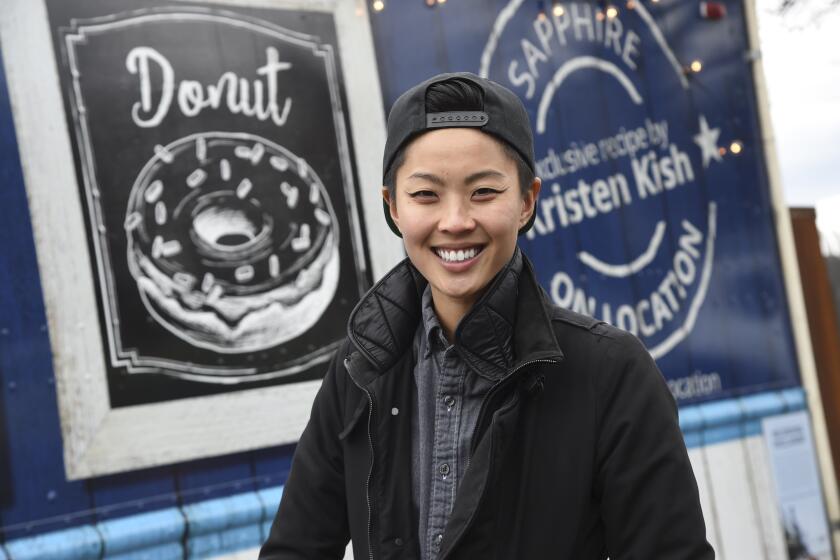A Glossary of Oriental Noodles : A Variety of Shapes Can Be Purchased Dry or Fresh
- Share via
Today, many varieties of Oriental noodles are manufactured in Los Angeles and are available in fresh and dry forms. However, some noodles, particularly rice and mung bean noodles, are imported from Thailand, China, Japan and Korea, giving the buyer an opportunity to test the various types.
Rice-based noodles, generally called rice sticks, are probably the most common and come in a variety of shapes, sizes, colors and thicknesses. But there also are noodles made from wheat, buckwheat, mung bean, egg and even green tea, with credit given to China as the inspiration for all noodles ( mein ).
Folded or Stacked
Noodles may be found wrapped like folded ribbons or packaged like stick spaghetti in various widths and in flat or round shapes. They may be opaque and white--as are those that puff to several times their volume when fried for use in Chinese chicken salad--or thin like vermicelli for adding to stir-fried chow mein dishes. Cellophane noodles--somewhat transparent, translucent noodles made from mung beans--are prized in soups and stir-fry dishes.
Japanese noodles also come in numerous colors, shapes and sizes, from white wheat to gray buckwheat or green tea.
Imported varieties of Thai rice sticks (sen mee) used in stir-fried dishes and soups, as well as the famous mee krob, which requires deep frying, generally are soaked before using. Gwaytio noodles, the wide fresh noodles used as the first meal of a Thai day, are commercially available as pancakes in vacuum packets.
Noodles also are a staple of Korean cuisine. Among the most popular are very thin white wheat or buckwheat noodles and thin transparent cellophane noodles. If Oriental noodles are not available for Korean cooking, substitute regular pasta noodles of varying sizes, from very thin vermicelli to fat macaroni.
Here is a description and suggested method of cooking for some of the Oriental noodles used in our recipes, commonly found in supermarkets and Oriental food stores.
Bean threads-- Also called cellophane noodles or silver threads and are like rice sticks, but slightly thinner and translucent. Made from starchy liquid leached from pureed mung beans, the tough threads require soaking to soften. Soak in warm water 20 minutes, then cook in boiling water three minutes. Drain and rinse in cold water. Use in soups, stir-fry dishes or deep fried to add as toppings to salads and stir-fry dishes.
Rice sticks --Used throughout the Orient. Specific names for these noodles vary depending on their size and shape and place of origin . They can be used as you would spaghetti or spaghettini or cappellini (angel-hair pasta), cooking thin ones quickly in boiling, salted water for three to four minutes, depending on the thickness of the pasta. The thicker varieties require longer cooking. Most always they are rinsed in cold water to remove excess starch before using.
Another variety of rice sticks, called banh pho in Vietnamese and mei fun in Chinese, are white, dry opaque noodles. The stringlike noodles are bundled in see-through packages and expand to double their volume when fried or cooked. They are used in Chinese chicken salad and soups and with barbecued meats. In Thai cuisine they are used to make mee krob --sweet, deep fried noodles. To use, soak in cold water 20 minutes. Cut, if necessary, and cook two to three minutes to use in soups and stir-fry dishes. Noodles can be crisp-fried by dropping them from the package into hot oil until they puff to several times their original volume. Use in salads or as crushed toppings for stir-fry dishes or salads.
Bon Mein ( bun in Vietnamese)--Wheat flour egg noodles used like vermicelli in stir-fry or pan-fried chow mein and braised lo mein noodle dishes as well as soups.
Udon-- Fat, white wheat noodles sold fresh (vacuum-packed) or dried. The most popular Japanese noodle, chiefly used for soups. Fresh noodles are now available vacuum-packed in most supermarket dairy counters. They may be prepared ahead ready to add to soups. Cook in boiling water until just tender and rinse in cold water. Sprinkle with oil and cover with cloth until ready to add to soups. Avoid overcooking.
Kishimen-- Flat fettuccine-type noodle, a variation of Japanese udon used in place of rice in sukiyaki dishes. Cook with other foods in broth or water until done, then lift out of cooking liquid and eat with dipping sauces or natural juices from stewed foods.
Soba-- Thick or thin and caramel-colored from buckwheat flour. Eaten like udon, hot and wet, cold and slightly dry, or on ice for summer salads. Cook in boiling water one minute, then drain in colander and rinse in cold water. Place ice cubes over noodles if cold summer noodles are desired. Serve dipped in dipping sauce or soy sauce.
Somen-- Thinnest Japanese noodle made from wheat flour and prepared like soba or rice sticks. Cook in boiling water one minute, then drain in colander and rinse in cold water. Cover noodles with damp cloth if not using immediately.
Spaghetti noodles-- Egg noodles resembling Italian spaghetti used like spaghetti with sauces and other toppings. Cook as you would spaghetti, but avoid overcooking for best results.
Ramen-- Same as Chinese egg noodles (bon mein). Plunge into boiling broth to use as main ingredient in soup with or without desired toppings.
Korean wheat noodles-- The preferred white wheat noodle, usually served in broth. Wheat noodles are also served seasoned with soy sauce and topped with a variety of meats and vegetables. Cook noodles as you would spaghetti until firm-tender. Drain in colander and rinse under cold running water to remove excess starch.
More to Read
Eat your way across L.A.
Get our weekly Tasting Notes newsletter for reviews, news and more.
You may occasionally receive promotional content from the Los Angeles Times.










